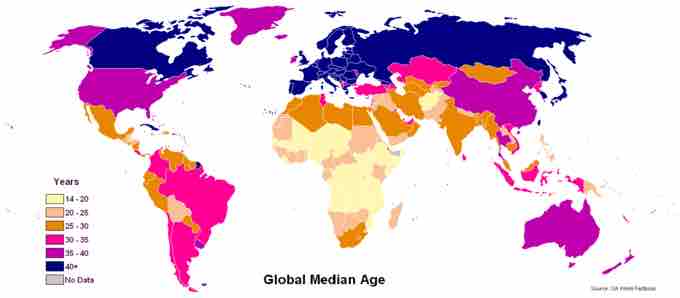The number of individuals living into old age is growing worldwide. While the trend of an aging population is obvious, it can be difficult to assess because the definition of "old age" depends entirely on the cultural norms of a given society. Biological markers for old age (such as wrinkles, grey hair, memory loss, etc.) exist, but old age can also be defined by when an individual begins to fill certain social roles, such as becoming a grandparent or retiring. All of these factors vary by culture.
Statistics on Age
Nevertheless, the fact is that people are living longer and are therefore more prone to encounter issues associated with old age. In industrialized nations, life expectancy has increased consistently over the last decades. In the United States, the proportion of people aged 65 or older increased from 4 percent in 1900 to about 12 percent in 2000. In 1900, only about 3 million Americans were 65 or older, out of a total population of 76 million Americans. By 2000, the number of senior citizens had increased to 35 million out of 280 million Americans. Population experts estimate that more than 50 million Americans, or 17 percent of the population, will be 65 or older in 2020. The number of older Americans has spiked in recent years due to the age of baby boomers—the generation that was born in the twenty years following World War II. As soldiers returned from war, families began to grow. This generation is now beginning to enter their older years.
The United States Census provides more specific information about the make up of older Americans. According to the census, there has been rapid growth among the elderly segment of the population in recent years. The population of people aged 65 and older grew at a faster rate than the total population. While women still live longer than men, the gender gap among seniors is narrowing. Further, there appear to be regional divides in the demographic breakdown of senior citizens. The South had the largest number of people aged 65 and up, while the Northeast had the largest percentage of people aged 65 and up. In 2010, 53,364 centenarians, or people over the age of 100, lived in the United States, a 5.8 percent increase from the number of centenarians in 2000. This means that 1 out of every 5,786 Americans is over the age of 100.
While the trend of an older population appears worldwide, people in industrialized nations are older than people in non-industrialized nations. While people in almost all countries are living longer than prior generations, people in industrialized nations still live longer than people in non-industrialized nations. According to the Population Research Bureau, the average life expectancy in Africa is 53, in North America is 78, in Latin America is 73, in Asia is 68, in Europe is 75, and in Oceania is 75. Some of this difference can be attributed to disparities in health care—easier access to pervasive biotechnology in industrialized nations means that people live longer. Other factors include poverty and a generally more strenuous lifestyle, which can cause health problems and a lower life expectancy.

Global Median Age
Average age by country